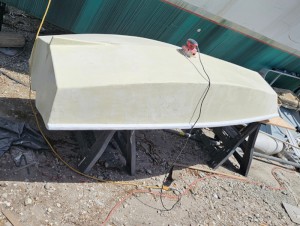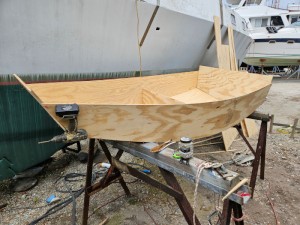Kaimusailing
s/v Kaimu Wharram Catamaran
| Vessel Name: | Kaimu |
| Vessel Make/Model: | Wharram Custom |
| Hailing Port: | Norwalk, CT |
| Crew: | Andy and the Kaimu Crew |
| About: | Sailors in the Baltimore, Annapolis, DC area. |
17 April 2024 | St Marys, GA
Dinghy Skeg
I was suffering with what seemed like a cold and also had allergy symptoms. I awoke and felt fine. The green pollen that was coating everything was gone. Maybe it will return.
07 April 2024 | St. Marys, GA
Clammy Hands
Items came in from TEMU, the Chinese cut rate retailer. One was a nice little drone that cost about twelve and a half dollars. It looked like an easy thing to play with while I coughed and sneezed. I was fighting a summer cold, even though it is not summer elsewhere, it seems like it here. A nice [...]
02 April 2024 | St. Marys, GA
Sun Doggie
After laminating the cedar strips onto the gunwales of the dinghy I found the screws I used wouldn’t come out. The epoxy had seized them. The screw heads were stripped so I cut a straight slot in the heads with the cut off wheel. The cedar smoked when the screw heads got red hot. I could remove [...]
21 March 2024 | St. Marys, GA
Just Add Water
The rainy weekend started off with overcast and fog but no rain. It looked like I might be able to get something done on the D4 dinghy. I wanted to change the bow seat which is really the bow deck. The sailing option uses the deck to hold the freestanding mast. I didn’t like how the deck looked, [...]
01 March 2024 | St. Marys, GA
D4 Dinghy Alternative Seats
The rain event was more wind than rain, strong winds with gusts up to 44 mph. We drove into town to see what the harbor was like. There was a small sailboat that had dragged anchor and was sitting close to shore. The tide was out. We left and played with Bleu at Notter’s Pond.
23 February 2024 | St. Marys, GA
D4 Inside Seams
Day two of the dinghy build started out with me finishing wiring the hull bottoms together on the centerline of the bottom panels. This was much easier than the wiring of the chine edges of the bottom panels and the side panels.
Engine Swap in Several Parts

.
The weather is mild here close to the sea and south of the Cape. I contemplated working on the Yamaha again and did not feel motivated. I was still numb and felt more like resting for a few days. I had been thinking about replacing the Yamaha with a smaller engine, around 25 HP, and electronic fuel injection, which would be as invulnerable to bad fuel as any modern automotive engine. I began researching engines from Honda, Yamaha, Tohatsu, and Suzuki. Prices were reasonable for this smaller engine, around $3,500 and up. With Yamaha I could use the existing remote controls, for the others I would have to add them to the package. I looked at eBay and Craigslist and then found a Suzuki 25 HP that had been listed almost a month ago on Craigslist that had the remote controls, was fuel injected, electric start, power trim and tilt, a 2016 model, and had only 50 hours on it. I contacted the seller and was glad to find the engine was still available. He said it only weighed 127 pounds, much less than the Yamaha, and it had 4 years of warranty left on it. This sounded ideal, the only problem was the logistics to get the motor out to Kaimu at anchor.
.
New Year’s Eve day had me ashore and to the post office, then to Walmart for provisions and a new propane cylinder. John, the seller of the Suzuki engine, offered to give me a lift and saved me the cost of an Uber ride. He declined lunch and said he had an afternoon of festivities. He’s retired and a boat nut and we hit it off. We went to his abode to take a look at the engine and it looks like it’s brand new. 2 years old.
.
I ended up rowing back to Kaimu with a full propane cylinder, a case of water, several boxes of wine, more Progresso soup, and lots of other stuff. I was ready to hit the hay after loading all the stuff on board. I relaxed and started doing more research on the Suzuki motor. The big advantage is EFI, electronic fuel injection, which is impervious to ethanol fuel. This means you can fuel up with automotive gasoline which is about 2/3 the cost of marine gasoline. It’s not a case of saving money, it’s the opportunity to get gas wherever you can find it and not be waylaid by the problems that a carburetted engine has with the automotive fuel.
.
Changing out the motors is of course a daunting proposition. The Suzuki is about 150 lbs. and it has to be brought out to Kaimu and hoisted aboard. The Yamaha is much heavier and has to be hoisted up on deck out of the engine box and what to do with it then? It has value, it can be cleaned up and made to run, I suspect that it has had some bad gasoline in the 4 carburettors.
.
I began dreaming up ways to hoist the engines from the engine box, then realized the sled that they mount on could be swung down completely out of the way for the dinghy to park under the engine box. Then the outgoing engine could be lowered into the dinghy and then brought around to the bow and hoisted on deck there. Then the new engine could be floated in the dinghy under the engine box and the engine hoisted and then lowered to be attached to the sled after it had been swung back into position. I drew plans and made a materials list for the lumber, fasteners, and a couple of large gate hinges. I called John who was selling the Suzuki engine and made plans to have lunch ashore and then go shopping for lumber.
.
We had lunch at Ribeye’s, a reasonably priced restaurant right near The General Store, where I had done a load of laundry, and had time to talk about a lot of things. We went lumber shopping, also stopped in at the Suzuki dealer to order a gasline fitting for the new motor. I picked up some 50 ohm coax cable to make a VHF antenna for the main radio. The old antenna was at the bottom of the sea.
.
John’s truck was going flat on the passenger front tire, so we went to Mr. Tire, then went to John’s local mechanic in his neighborhood. While the truck was parked there we found a nail buried in the tire. I had thought it was something picked up from the street, slightly red, but John looked more closely and identified it as a rusty nail. The mechanic fixed it right away right where the truck was parked. He dragged an air line out and inflated the tire and we were off. Very lucky.
.
I rowed the dinghy, packed with a big bag of clean laundry, two 2X6‘s, five 2X4‘s, a 2X2 hobby panel, boxes of stainless deck screws, and the coax cable. I quickly loaded the foredeck with the supplies, then stowed the laundry and anything that would get ruined by rain in the pilothouse.
.
The next day I started my to do list for the engine swap. It started with “Buy Lumber” and ended with “Install Suzuki”. I turned on the inverter and got out a drill and circular saw. The hoisting frame, which we started calling a gantry, was like a large sawhorse about 6 feet high and two of the legs were on hinges with some dynema line keeping them from sliding out under load. Think of it as a large upside down U with two legs hinged at the top to make a sawhorse. There were gussets to strengthen the upside down U. It was very easy to make and didn’t take long. The drill was for driving deck screws to assemble the gantry.
.
The Yamaha had to be disconnected from everything before it could be taken away, so the throttle and gear shift cables were disconnected, the electrical umbilical cord was unplugged, and the heavy battery cables were disconnected. I found that the battery cable to the starter solenoid was corroded and maybe that was the cause of that problem. Finally, the mechanical attachment which was 4 stainless eyebolts had to be removed and they were corroded in place, stainless passing through aluminum. I finally had to cut them off with the angle grinder and a cut off wheel.
.
The gantry was positioned above the engine box and 3 turns of dynema were shackled to the engine and another 3 turns were wrapped around the middle of the gantry cross arm to form lifting straps for a come-along. I already had the engine sled winched up at its highest setting, now the come-along lifted the engine even higher. Then I went down in the dinghy to undo the redundant straps that held the engine sled. Now the engine sled was held up by the winch. I lowered away and the sled swung down, underwater, pivoting out of the way.
.
The photo is of the engine hoisted up in the engine box.






